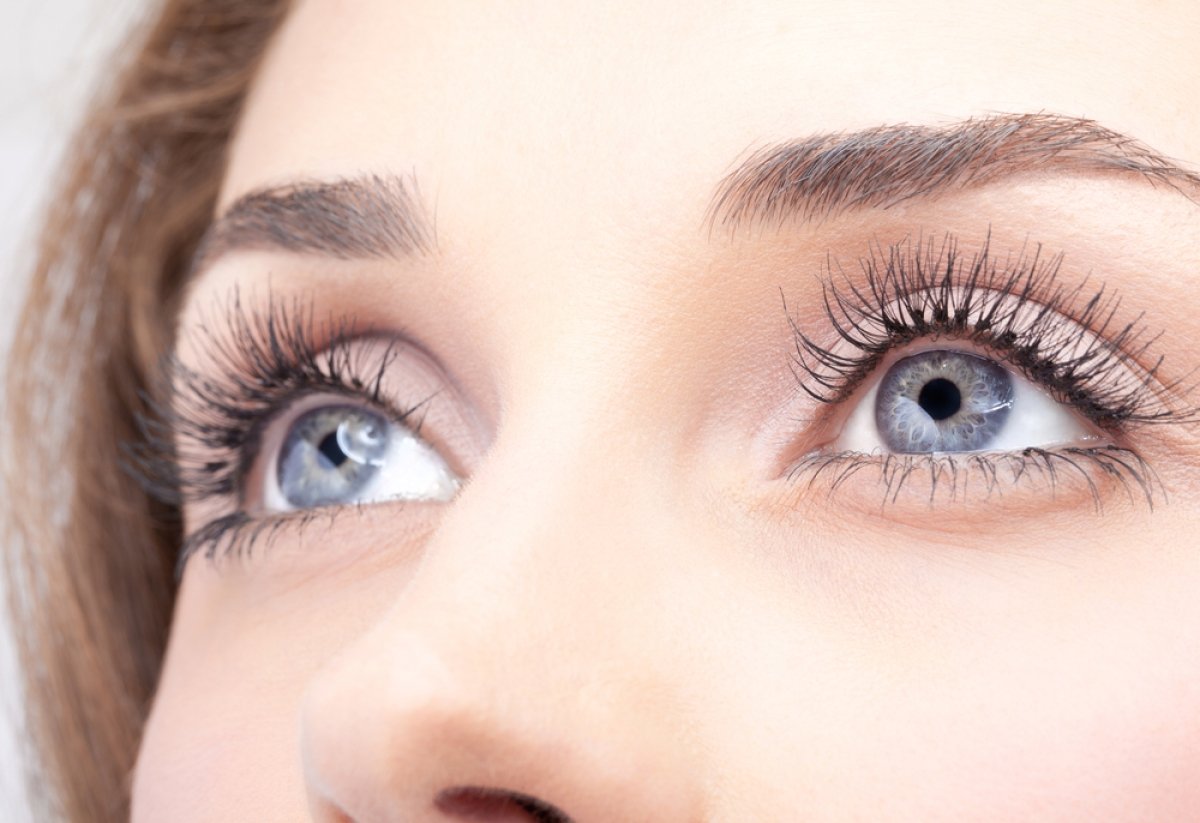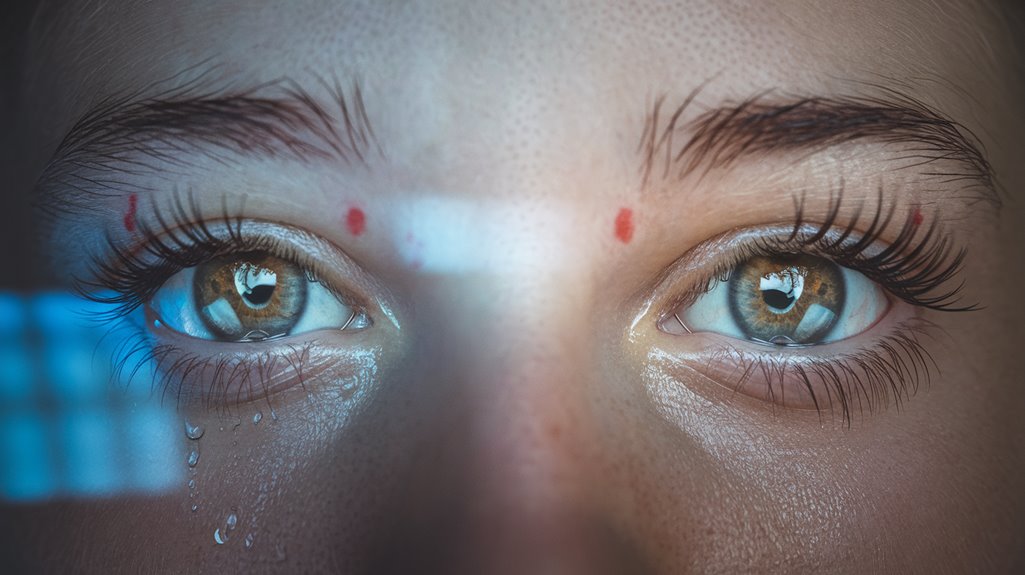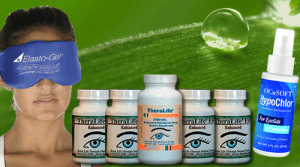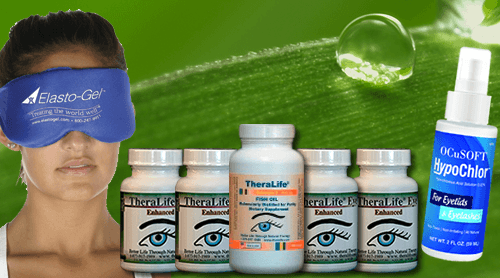TheraLife offers products that extensively benefit customers by addressing various eye conditions related to excessive screen time and its impact on eye health. The products help stabilize the tear film, reducing instances of watery eyes caused by screen exposure. TheraLife’s natural solutions are designed to improve blinking rates and relieve ocular surface dryness and irritation, thereby preventing tear film instability and reflex tearing. Their product line includes specialized treatments for conditions such as blepharitis, dry eyes, and uveitis, among others, by harnessing natural ingredients to provide relief and support ocular health effectively.
TheraLife also advises on lifestyle changes and dietary adjustments to further enhance eye health and reduce symptoms associated with digital eye strain, such as blurred vision and headaches. By utilizing TheraLife’s products and following recommended strategies like the 20-20-20 rule, adjusting screen ergonomics, and maintaining ambient humidity, customers can manage symptoms more effectively and protect their long-term eye health.
Understanding these factors can help you manage symptoms and protect long-term ocular health effectively. There’s more to learn about prevention techniques and care essentials from TheraLife’s comprehensive resources.
Stop Your Watery Eyes By Treating Your Dry Eyes With TheraLife
Add To Cart
All Natural Oral Dry Eye Treatment That Works.
Eye drops don’t work for watery eyes
Key Takeaways
- Excessive screen time can exacerbate digital eye strain, leading to symptoms like watery eyes and visual discomfort.
- Extended use of digital screens reduces blinking frequency, contributing to tear film instability and irritation.
- Implementing the 20-20-20 rule helps minimize eye strain and reduce watery eyes caused by prolonged screen exposure.
- Regular breaks and proper screen positioning are essential to prevent watery eyes and maintain eye health.
- Increased screen time has been linked to a rise in cases of dry eyes and excessive tearing.
Causes of Watery Eyes
Watery eyes, medically known as epiphora, can arise from a variety of causes, each rooted in different physiological or environmental factors.
Allergies, including allergic rhinitis and conjunctivitis, are prevalent causes. For effective allergies management, you should consider antihistamines or avoiding known allergens. Protective eyewear can also serve as a barrier against wind, dust, and allergens, reducing the risk of exposure and subsequent tearing.
Another significant factor is tear duct blockage, which can stem from congenital defects or acquired conditions like dacryostenosis. This blockage disrupts normal tear drainage, leading to overflow. In babies, nasolacrimal ducts may not be fully open and functioning for the first several months of life, contributing to tear duct blockages.
Additionally, foreign objects in the eye, such as dust or sand, can trigger irritation and excessive tearing.
In addressing these issues, you must focus on appropriate interventions, whether through medical treatment or environmental adjustments.
Understanding these causes is vital for developing effective strategies to manage and mitigate watery eyes.
Eye Strain From Screens
Understanding the causes of watery eyes lays the groundwork for addressing another modern concern—eye strain resulting from extensive screen use. Prolonged exposure to digital devices induces digital fatigue, exacerbated by screen glare. This phenomenon stresses ocular muscles, leading to discomfort. Consider these contributing factors:
- Prolonged Screen Time: Extended hours on devices heighten the risk of eye strain.
- Screen Glare: Bright screens force your eyes to work harder, intensifying strain.
- Lack of Breaks: Continuous reading without rest can aggravate symptoms.
- Underlying Conditions: Dry eyes or uncorrected vision issues can worsen the effects. Chronic dry eyes can lead to complications such as blepharitis and meibomian gland dysfunction, further worsening eye strain.
Addressing these elements involves modifying screen settings, improving posture, and adopting practices like the 20-20-20 rule to mitigate digital fatigue and preserve ocular health. It’s important to note that extended computer and digital device use leads to computer vision syndrome, a condition characterized by symptoms like blurred vision and headaches.
Symptoms of Digital Eye Strain
Digital eye strain, a prevalent concern in our screen-dominated era, manifests through a variety of symptoms that signal ocular distress.
You may experience visual discomfort characterized by dryness and irritation due to reduced blinking and prolonged screen exposure. This can lead to eye hydration issues, resulting in a burning sensation or grittiness. Tear film instability, a common issue with dry eyes, can exacerbate these symptoms by causing dry spots on the cornea.
Temporary blurred vision often arises from eye muscle fatigue as you struggle to maintain focus. Headaches may occur from straining your eyes to decipher small text or images, compounded by poor posture.
Additionally, improper viewing distances and angles contribute to neck and shoulder pain. Blue light exposure, screen glare, and poor lighting exacerbate these symptoms, increasing the risk of long-term vision problems if not addressed. Blue light emitted from screens can also disrupt sleep patterns, further impacting your overall well-being.
Preventing Watery Eyes
To effectively prevent watery eyes, incorporate screen time management and thorough eye care practices into your routine. Limit screen exposure by adhering to the 20-20-20 rule and making sure screens are appropriately positioned and illuminated to minimize ocular strain. Additionally, maintain ocular hydration with frequent blinking and the use of lubricating eye drops, and make sure regular eye exams to detect any underlying conditions. Wearing wrap-around glasses outdoors can further protect your eyes from wind irritation, enhancing your overall eye health regimen. Consider using artificial tears to provide temporary relief, but be aware that they may worsen dryness over time.
Screen Time Management
When managing screen time to prevent watery eyes, it’s crucial to implement structured strategies backed by research. Establish clear screen time limits to mitigate digital eye strain, leveraging time management apps for precision. Incorporate device-free zones in your home or workplace to foster an ocular-friendly environment. Psychological factors, including stress and anxiety, have been found to correlate with increased dry eye symptoms, highlighting the importance of balanced screen habits. Monitor your device usage using built-in smartphone features to guarantee adherence to these limits. Research indicates that significant reduction in overall screen time is observed with strict limits. Here’s how you can manage screen time effectively:
- Set screen time limits: Allocate specific daily device usage durations.
- Designate device-free zones: Identify areas where screens are off-limits.
- Track usage: Utilize smartphones’ screen time functions to monitor and adjust daily and weekly usage.
- Schedule downtime: Program devices for essential use only during designated hours.
Implementing these strategies can greatly reduce the risk of watery eyes.
Eye Care Practices
Eye care practices are essential in preventing watery eyes, especially when managing screen time. Start with lid hygiene by washing your eyelids daily with baby shampoo on a warm washcloth. This prevents blepharitis, a common cause of watery eyes. Use over-the-counter lubricating eye drops to alleviate dryness and antihistamine eye drops for allergy relief. Maintaining bedroom humidity at 40% or higher aids tear production and can prevent dry eyes from exacerbating into excessive tearing. Incorporate the 20-20-20 rule to reduce digital eye strain, which can also help in minimizing excessive tearing.
Long-Term Vision Effects
Excessive screen time can have significant long-term effects on your vision, impacting both comfort and eye health. Screen fatigue may lead to discomfort, reducing visual wellness over time.
Common issues include:
- Dry eyes: Persistent use of screens causes dryness and irritation.
- Blurred vision: Difficulty focusing on distant objects is a frequent result.
- Headaches: Strain on the temples is often reported after prolonged screen exposure.
- Blue light exposure: This can lead to macular degeneration and disrupt sleep cycles.
Research shows that excessive blue light harms retinal cells and increases the risk of myopia, especially in children. Increased screen time correlates with a rise in digital eye strain cases, emphasizing the importance of managing screen exposure to safeguard visual health. Maintaining a balance in screen time is essential to preventing these conditions and ensuring long-term visual health. Adhering to screen time guidelines is vital for protecting your vision.
Importance of Eye Care
Despite the demands of modern life, prioritizing regular eye care is essential for maintaining ideal visual health. Thorough eye exams serve as preventative measures, essential for detecting conditions like cataracts, diabetic retinopathy, and glaucoma early. For children’s vision, early detection of amblyopia and other issues is important, with exams recommended between ages 3 and 5. These exams help prevent long-term vision problems, ensuring healthy development. Additionally, regular eye exams can uncover systemic health issues like high blood pressure and diabetes. Protecting eyes from harmful UVA and UVB rays using sunglasses and practicing the 20-20-20 rule during screen time are important strategies. Healthy habits, including diet and exercise, further support ocular health, reducing risks of dry eye and digital strain. Incorporating leafy greens like spinach and kale into your diet can significantly boost eye health. Adequate tear production is crucial for maintaining eye moisture and preventing irritation, with age and hormonal changes potentially affecting this natural process.
Frequently Asked Questions
Can Dietary Changes Help Alleviate Watery Eyes From Screen Use?
You can alleviate watery eyes by implementing dietary changes.
Enhance hydration habits by consuming plenty of water and hydrating foods, while reducing dehydrating beverages.
Incorporate omega-3 rich foods like salmon and walnuts, or consider dietary supplements if needed.
A balanced diet with antioxidants from fruits and vegetables supports eye health.
Such nutritional adjustments can markedly reduce symptoms, according to research on ocular health and tear film stability.
Are Certain Screen Types Better for Reducing Eye Strain?
When considering which screen types reduce eye strain, you should focus on blue light emission.
LED screens, a common type of LCD, emit significant blue light, which can contribute to eye discomfort. However, newer LED models incorporate features to minimize this effect.
OLED displays offer advantages by illuminating individual pixels, thereby reducing blue light exposure.
For ideal eye health, consider OLED or E-Ink displays, as they align with research on minimizing eye strain.
How Does Screen Time Affect Children’s Eye Development?
You might wonder if screen exposure hinders children’s visual development. Research suggests excessive screen time can indeed disrupt natural eye growth, increasing myopia risk.
The focusing system becomes strained, and reduced outdoor activity exacerbates this issue. Blue light exposure can also affect sleep, indirectly impacting visual health.
To support healthy development, limit screen exposure, encourage breaks, and promote outdoor activities. It’s essential to monitor eye health regularly for early intervention.
What Role Do Air Purifiers Play in Preventing Watery Eyes?
You mightn’t realize it, but improving air quality with air purifiers plays an essential role in preventing watery eyes.
These devices filter out allergens like pollen and dust, providing allergy relief. Using HEPA filters, they efficiently remove particulates, reducing inflammation and eye irritation.
While it’s not a substitute for medical treatment, an air purifier can greatly enhance your environment by minimizing airborne irritants, supporting your overall eye health and comfort.
Can Eyewear Help Mitigate the Effects of Screen Time on Eyes?
Imagine the soothing relief your eyes could feel. Yes, eyewear can help mitigate screen time effects.
Blue light blocking glasses equipped with anti-reflective lenses can greatly reduce exposure to harmful light, alleviating digital eye strain. Research indicates that these lenses filter high-energy visible light, decreasing eye fatigue and long-term risks like macular degeneration.
Stop Your Watery Eyes By Treating Your Dry Eyes With TheraLife
Add To Cart
All Natural Oral Dry Eye Treatment That Works.
Eye drops don’t work for watery eyes
Conclusion
Theralife.com offers a range of products and solutions designed to address various eye conditions, including those exacerbated by prolonged screen time, such as watery eyes from digital eye strain. For example, consider a university student dealing with persistent eye discomfort and tearing after hours of online classes. Theralife’s products, such as their specialized dry eye formulas, are designed to alleviate these symptoms by promoting eye hydration and reducing inflammation.
Theralife emphasizes the importance of adopting regular breaks and proper screen ergonomics to prevent eye strain. Additionally, their products support consistent eye care practices, like the 20-20-20 rule, to further mitigate discomfort. By prioritizing eye health with Theralife’s offerings, users can not only ease immediate discomfort but also protect their long-term vision, ensuring sustained ocular well-being.
Stop Your Watery Eyes By Treating Your Dry Eyes With TheraLife
Add To Cart
All Natural Oral Dry Eye Treatment That Works.
Eye drops don’t work for watery eyes
References
- Gupta P D and Muthukumar Anbazhagi. (2018) Minor to chronic eye disorders due to environmental pollution. A review. J Ocul Infect Inflamm.
View at Publisher | View at Google Scholar - Eyelash length explained. Nature 519; (2015).
View at Publisher | View at Google Scholar - Amador GJ, DeMercurio Mao W, et al. (2015) Eyelashes divert airflow to protect the eye. J R Soc Interface. 12(105):20141294.
View at Publisher | View at Google Scholar - Shams PN, Chen PG, Wormald PJ, et al. (2014) Management of functional epiphora in patients with an anatomically patent dacryocystorhinostomy. JAMA Ophthalmol. 1132(9):1127-1132.
View at Publisher | View at Google Scholar - Cannon PS, Chan W, Selva D. (2013) Incidence of canalicular closure with endonasal dacryocystorhinostomy without intubation in primary nasolacrimal duct obstruction. .Ophthalmology. 120(8):1688-1692.
View at Publisher | View at Google Scholar - Ullrich K, Malhotra R, Patel BC. (2020) Dacryocystorhinostomy In: StatPearls. Treasure Island (FL): StatPearls Publishing.
View at Publisher | View at Google Scholar - Hurwitz JJ. (1996) The lacrimal system. Philadelphia Lippincott-Raven Publishers.
View at Publisher | View at Google Scholar - Mainville N, Jordan DR. (2011) Etiology of tearing: A retrospective analysis of referrals to a tertiary care ocuplastics practice. Ophthal Plast Reconstr Surg. 27: 155-157.
View at Publisher | View at Google Scholar - Baguet J, Claudon-Eyl V, Sommer F, Chevallier P. (1995) Normal protein and glycoprotein profiles of reflex tears and trace element composition of basal tears from heavy and slight deposits on soft contact lenses. CLAO J. 21(2):114-121.
View at Publisher | View at Google Scholar - DA Dartt and MDP Willcox. (2013) Complexity of the tear film: Importance in homeostasis and dysfunction during disease Exp Eye Res. 117: 1-3.
View at Publisher | View at Google Scholar - Baguet J, Claudon-Eyl V, Sommer F, Chevallier P. (1995) Normal protein and glycoprotein profiles of reflex tears and trace element composition of basal tears from heavy and slight deposits on soft contact lenses. CLAO J. 21(2):114-121.
View at Publisher | View at Google Scholar - Becker BB. (1992) Tricompartment model of the lacrimal pump mechanism. Ophthalmology. 99(7):1139-1145.
View at Publisher | View at Google Scholar - Montoya, F., Riddell, C., Caesar, R. et al. (2002) Treatment of gustatory hyper lacrimation (crocodile tears) with injection of botulinum toxin into the lacrimal gland. Eye 16, 705-709.
View at Publisher | View at Google Scholar - 1.
2.
Nemet AY. The Etiology of Epiphora: A Multifactorial Issue. Semin Ophthalmol. 2016;31(3):275-9. [Abstract]3.
Shen GL, Ng JD, Ma XP. Etiology, diagnosis, management and outcomes of epiphora referrals to an oculoplastic practice. Int J Ophthalmol. 2016;9(12):1751-1755. [Abstract]4.
Patel J, Levin A, Patel BC. StatPearls [Internet]. StatPearls Publishing; Treasure Island (FL): Aug 7, 2023. Epiphora. [Abstract]5.
Gurnani B, Kaur K. StatPearls [Internet]. StatPearls Publishing; Treasure Island (FL): Jun 11, 2023. Bacterial Keratitis. [Abstract]6.
Basu S. Seeing through tears: Understanding and managing dry eye disease. Indian J Ophthalmol. 2023 Apr;71(4):1065-1066. [Abstract]7.
Icasiano E, Latkany R, Speaker M. Chronic epiphora secondary to ocular rosacea. Ophthalmic Plast Reconstr Surg. 2008 May-Jun;24(3):249. [Abstract]8.
9.
Tse DT, Erickson BP, Tse BC. The BLICK mnemonic for clinical-anatomical assessment of patients with epiphora. Ophthalmic Plast Reconstr Surg. 2014 Nov-Dec;30(6):450-8. [Abstract]10.
Webber NK, Setterfield JF, Lewis FM, Neill SM. Lacrimal canalicular duct scarring in patients with lichen planus. Arch Dermatol. 2012 Feb;148(2):224-7. [Abstract]11.
Portelinha J, Passarinho MP, Costa JM. Neuro-ophthalmological approach to facial nerve palsy. Saudi J Ophthalmol. 2015 Jan-Mar;29(1):39-47. [Abstract]12.
Zhang Y, Zeng C, Chen N, Liu C. Lacrimal ductal cyst of the medial orbit: a case report. BMC Ophthalmol. 2020 Sep 24;20(1):380. [Abstract]13.
Kim JS, Liss J. Masses of the Lacrimal Gland: Evaluation and Treatment. J Neurol Surg B Skull Base. 2021 Feb;82(1):100-106. [Abstract]14.
Lievens CW, Rayborn E. Tribology and the Ocular Surface. Clin Ophthalmol. 2022;16:973-980. [Abstract]15.
Al Saleh A, Vargas JM, Al Saleh AS. Supernumerary lacrimal puncta: Case series. Saudi J Ophthalmol. 2020 Oct-Dec;34(4):328-330. [Abstract]16.
Kang S, Seo JW, Sa HS. Cancer-associated epiphora: a retrospective analysis of referrals to a tertiary oculoplastic practice. Br J Ophthalmol. 2017 Nov;101(11):1566-1569. [Abstract]17.
Esmaeli B, Hidaji L, Adinin RB, Faustina M, Coats C, Arbuckle R, Rivera E, Valero V, Tu SM, Ahmadi MA. Blockage of the lacrimal drainage apparatus as a side effect of docetaxel therapy. Cancer. 2003 Aug 01;98(3):504-7. [Abstract]18.
Chan W, Malhotra R, Kakizaki H, Leibovitch I, Selva D. Perspective: what does the term functional mean in the context of epiphora? Clin Exp Ophthalmol. 2012 Sep-Oct;40(7):749-54. [Abstract]19.
Perry JD. Dysfunctional epiphora: a critique of our current construct of “functional epiphora”. Am J Ophthalmol. 2012 Jul;154(1):3-5. [Abstract]20.
Maroto Rodríguez B, Stoica BTL, Toledano Fernández N, Genol Saavedra I. Treatment for functional epiphora with botulinum toxin-A versus lateral tarsal strip in a randomized trial. Arch Soc Esp Oftalmol (Engl Ed). 2022 Oct;97(10):549-557. [Abstract]21.
Ozturker C, Purevdorj B, Karabulut GO, Seif G, Fazil K, Khan YA, Kaynak P. A Comparison of Transcanalicular, Endonasal, and External Dacryocystorhinostomy in Functional Epiphora: A Minimum Two-Year Follow-Up Study. J Ophthalmol. 2022;2022:3996854. [Abstract]22.
Lee MJ, Park J, Yang MK, Choi YJ, Kim N, Choung HK, Khwarg SI. Long-term results of maintenance of lacrimal silicone stent in patients with functional epiphora after external dacryocystorhinostomy. Eye (Lond). 2020 Apr;34(4):669-674. [Abstract]23.
Shams PN, Chen PG, Wormald PJ, Sloan B, Wilcsek G, McNab A, Selva D. Management of functional epiphora in patients with an anatomically patent dacryocystorhinostomy. JAMA Ophthalmol. 2014 Sep;132(9):1127-32. [Abstract]24.
Vagge A, Ferro Desideri L, Nucci P, Serafino M, Giannaccare G, Lembo A, Traverso CE. Congenital Nasolacrimal Duct Obstruction (CNLDO): A Review. Diseases. 2018 Oct 22;6(4) [Abstract]25.
Mainville N, Jordan DR. Etiology of tearing: a retrospective analysis of referrals to a tertiary care oculoplastics practice. Ophthalmic Plast Reconstr Surg. 2011 May-Jun;27(3):155-7. [Abstract]26.
Ulusoy MO, Kıvanç SA, Atakan M, Akova-Budak B. How Important Is the Etiology in the Treatment of Epiphora? J Ophthalmol. 2016;2016:1438376. [Abstract]27.
Ishikawa S, Murayama K, Kato N. The proportion of ocular surface diseases in untreated patients with epiphora. Clin Ophthalmol. 2018;12:1769-1773. [Abstract]28.
Qian L, Wei W. Identified risk factors for dry eye syndrome: A systematic review and meta-analysis. PLoS One. 2022;17(8):e0271267. [Abstract]29.
Cher I. Fluids of the ocular surface: concepts, functions and physics. Clin Exp Ophthalmol. 2012 Aug;40(6):634-43. [Abstract]30.
Martin R, Emo Research Group Comparison of the Ocular Surface Disease Index and the Symptom Assessment in Dry Eye Questionnaires for Dry Eye Symptom Assessment. Life (Basel). 2023 Sep 21;13(9) [Abstract]31.
Kinoshita S, Ukyo H, Masuda N, Osawa S. Comparison of the Postoperative Outcomes of Posterior Layer Advancement and Modified Iliff Suturing to Correct Involutional Lower Lid Entropion. J Craniofac Surg. 2021 May 01;32(3):1143-1146. [Abstract]32.
Milbratz-Moré GH, Pauli MP, Lohn CLB, Pereira FJ, Grumann AJ. Lower Eyelid Distraction Test: New Insights on the Reference Value. Ophthalmic Plast Reconstr Surg. 2019 Nov/Dec;35(6):574-577. [Abstract]33.
Chen C, Malhotra R, Muecke J, Davis G, Selva D. Aberrant facial nerve regeneration (AFR): an under-recognized cause of ptosis. Eye (Lond). 2004 Feb;18(2):159-62. [Abstract]34.
Zhang YH, Feng J, Yi CY, Deng XY, Zhou YJ, Tian L, Jie Y. Dynamic tear meniscus parameters in complete blinking: insights into dry eye assessment. Int J Ophthalmol. 2023;16(12):1911-1918. [Abstract]35.
Abraham ZS, Bukanu F, Kahinga AA. A missed giant rhinolith retained for a decade in a paediatric patient at a zonal referral hospital in Central Tanzania: Case report and literature review. Int J Surg Case Rep. 2022 Oct;99:107622. [Abstract]36.
Bron AJ, de Paiva CS, Chauhan SK, Bonini S, Gabison EE, Jain S, Knop E, Markoulli M, Ogawa Y, Perez V, Uchino Y, Yokoi N, Zoukhri D, Sullivan DA. TFOS DEWS II pathophysiology report. Ocul Surf. 2017 Jul;15(3):438-510. [Abstract]37.
Singh Bhinder G, Singh Bhinder H. Reflex epiphora in patients with dry eye symptoms: role of variable time Schirmer-1 test. Eur J Ophthalmol. 2005 Jul-Aug;15(4):429-33. [Abstract]38.
Li N, Deng XG, He MF. Comparison of the Schirmer I test with and without topical anesthesia for diagnosing dry eye. Int J Ophthalmol. 2012;5(4):478-81. [Abstract]39.
Mou Y, Xiang H, Lin L, Yuan K, Wang X, Wu Y, Min J, Jin X. Reliability and efficacy of maximum fluorescein tear break-up time in diagnosing dry eye disease. Sci Rep. 2021 Jun 01;11(1):11517. [Abstract]40.
Sall K, Foulks GN, Pucker AD, Ice KL, Zink RC, Magrath G. Validation of a Modified National Eye Institute Grading Scale for Corneal Fluorescein Staining. Clin Ophthalmol. 2023;17:757-767. [Abstract]41.
Bunya VY, Chen M, Zheng Y, Massaro-Giordano M, Gee J, Daniel E, O’Sullivan R, Smith E, Stone RA, Maguire MG. Development and Evaluation of Semiautomated Quantification of Lissamine Green Staining of the Bulbar Conjunctiva From Digital Images. JAMA Ophthalmol. 2017 Oct 01;135(10):1078-1085. [Abstract]42.
Jamerson EC, Elhusseiny AM, ElSheikh RH, Eleiwa TK, El Sayed YM. Role of Matrix Metalloproteinase 9 in Ocular Surface Disorders. Eye Contact Lens. 2020 Mar;46 Suppl 2:S57-S63. [Abstract]43.
Papas EB. Diagnosing dry-eye: Which tests are most accurate? Cont Lens Anterior Eye. 2023 Oct;46(5):102048. [Abstract]44.
Wolffsohn JS, Arita R, Chalmers R, Djalilian A, Dogru M, Dumbleton K, Gupta PK, Karpecki P, Lazreg S, Pult H, Sullivan BD, Tomlinson A, Tong L, Villani E, Yoon KC, Jones L, Craig JP. TFOS DEWS II Diagnostic Methodology report. Ocul Surf. 2017 Jul;15(3):539-574. [Abstract]45.
Singh S, Donthineni PR, Srivastav S, Jacobi C, Basu S, Paulsen F. Lacrimal and meibomian gland evaluation in dry eye disease: A mini-review. Indian J Ophthalmol. 2023 Apr;71(4):1090-1098. [Abstract]46.
Wong S, Srinivasan S, Murphy PJ, Jones L. Comparison of meibomian gland dropout using two infrared imaging devices. Cont Lens Anterior Eye. 2019 Jun;42(3):311-317. [Abstract]47.
Chidi-Egboka NC, Jalbert I, Chen J, Briggs NE, Golebiowski B. Blink Rate Measured In Situ Decreases While Reading From Printed Text or Digital Devices, Regardless of Task Duration, Difficulty, or Viewing Distance. Invest Ophthalmol Vis Sci. 2023 Feb 01;64(2):14. [Abstract]48.
Pult H, Riede-Pult B. Comparison of subjective grading and objective assessment in meibography. Cont Lens Anterior Eye. 2013 Feb;36(1):22-7. [Abstract]49.
Kashkouli MB, Mirzajani H, Jamshidian-Tehrani M, Pakdel F, Nojomi M, Aghaei GH. Reliability of fluorescein dye disappearance test in assessment of adults with nasolacrimal duct obstruction. Ophthalmic Plast Reconstr Surg. 2013 May-Jun;29(3):167-9. [Abstract]50.
Bowyer JD, Holroyd C, Chandna A. The use of the fluorescein disappearance test in the management of childhood epiphora. Orbit. 2001 Sep;20(3):181-187. [Abstract]51.
Paramanathan N, Nemet A, Lee SE, Benger RS. A modified Jones test: lacrimal scintigram correlation. Ophthalmic Plast Reconstr Surg. 2011 Mar-Apr;27(2):81-6. [Abstract]52.
Pujari A, Bajaj MS, Sharma P. Calibrated Bowman’s lacrimal probe. Indian J Ophthalmol. 2018 Mar;66(3):478. [Abstract]53.
Shapira Y, Juniat V, Macri C, Selva D. Syringing has limited reliability in differentiating nasolacrimal duct stenosis from functional delay. Graefes Arch Clin Exp Ophthalmol. 2022 Sep;260(9):3037-3042. [Abstract]54.
Kim S, Yang S, Park J, Lee H, Baek S. Correlation Between Lacrimal Syringing Test and Dacryoscintigraphy in Patients With Epiphora. J Craniofac Surg. 2020 Jul-Aug;31(5):e442-e445. [Abstract]55.
Singla A, Ballal S, Guruvaiah N, Ponnatapura J. Evaluation of epiphora by topical contrast-enhanced CT and MR dacryocystography: which one to choose? Acta Radiol. 2023 Mar;64(3):1056-1061. [Abstract]56.
Timlin HM, Keane PA, Ezra DG. Characterizing Congenital Double Punctum Anomalies: Clinical, Endoscopic, and Imaging Findings. Ophthalmic Plast Reconstr Surg. 2019 Nov/Dec;35(6):549-552. [Abstract]57.
Zheng Q, Shen T, Luo H, Hong C, He J, Gong J, Jiang J. Application of lacrimal endoscopy in the diagnosis and treatment of primary canaliculitis: Practical technique and graphic presentation. Medicine (Baltimore). 2019 Aug;98(33):e16789. [Abstract]58.
Bae SH, Park J, Lee JK. Comparison of digital subtraction dacryocystography and dacryoendoscopy in patients with epiphora. Eye (Lond). 2021 Mar;35(3):877-882. [Abstract]59.
Mirshahvalad SA, Chavoshi M, Bahmani Kashkouli M, Fallahi B, Emami-Ardakani A, Manafi-Farid R. Diagnostic value of lacrimal scintigraphy in the evaluation of lacrimal drainage system obstruction: a systematic review and meta-analysis. Nucl Med Commun. 2022 Aug 01;43(8):860-868. [Abstract]60.
Singh S, Ali MJ, Paulsen F. Dacryocystography: From theory to current practice. Ann Anat. 2019 Jul;224:33-40. [Abstract]61.
Semp DA, Beeson D, Sheppard AL, Dutta D, Wolffsohn JS. Artificial Tears: A Systematic Review. Clin Optom (Auckl). 2023;15:9-27. [Abstract]62.
Karpecki P, Barghout V, Schenkel B, Huynh L, Khanal A, Mitchell B, Yenikomshian M, Zanardo E, Matossian C. Real-world treatment patterns of OTX-101 ophthalmic solution, cyclosporine ophthalmic emulsion, and lifitegrast ophthalmic solution in patients with dry eye disease: a retrospective analysis. BMC Ophthalmol. 2023 Nov 02;23(1):443. [Abstract]63.
Hauswirth SG, Kabat AG, Hemphill M, Somaiya K, Hendrix LH, Gibson AA. Safety, adherence and discontinuation in varenicline solution nasal spray clinical trials for dry eye disease. J Comp Eff Res. 2023 Jun;12(6):e220215. [Abstract]64.
Song MS, Lee Y, Paik HJ, Kim DH. A Comprehensive Analysis of the Influence of Temperature and Humidity on Dry Eye Disease. Korean J Ophthalmol. 2023 Dec;37(6):501-509. [Abstract]65.
Perfluorohexyloctane ophthalmic solution (Miebo) for dry eye disease. Med Lett Drugs Ther. 2024 Jan 22;66(1694):13-14. [Abstract]66.
Villani E, Marelli L, Dellavalle A, Serafino M, Nucci P. Latest evidences on meibomian gland dysfunction diagnosis and management. Ocul Surf. 2020 Oct;18(4):871-892. [Abstract]67.
Quan NG, Leslie L, Li T. Autologous Serum Eye Drops for Dry Eye: Systematic Review. Optom Vis Sci. 2023 Aug 01;100(8):564-571. [Abstract]68.
Zheng N, Zhu SQ. Randomized controlled trial on the efficacy and safety of autologous serum eye drops in dry eye syndrome. World J Clin Cases. 2023 Oct 06;11(28):6774-6781. [Abstract]69.
Shorter E, Nau CB, Fogt JS, Nau A, Schornack M, Harthan J. Patient Experiences With Therapeutic Contact Lenses and Dry Eye Disease. Eye Contact Lens. 2024 Feb 01;50(2):59-64. [Abstract]70.
Hussain M, Shtein RM, Pistilli M, Maguire MG, Oydanich M, Asbell PA., DREAM Study Research Group. The Dry Eye Assessment and Management (DREAM) extension study – A randomized clinical trial of withdrawal of supplementation with omega-3 fatty acid in patients with dry eye disease. Ocul Surf. 2020 Jan;18(1):47-55. [Abstract]71.
Kulkarni A, Banait S. Through the Smoke: An In-Depth Review on Cigarette Smoking and Its Impact on Ocular Health. Cureus. 2023 Oct;15(10):e47779. [Abstract]72.
Nagstrup AH. The use of benzalkonium chloride in topical glaucoma treatment: An investigation of the efficacy and safety of benzalkonium chloride-preserved intraocular pressure-lowering eye drops and their effect on conjunctival goblet cells. Acta Ophthalmol. 2023 Dec;101 Suppl 278:3-21. [Abstract]73.
Li Y, Xie L, Song W, Chen S, Cheng Y, Gao Y, Huang M, Yan X, Yang S. Association between dyslipidaemia and dry eye disease: a systematic review and meta-analysis. BMJ Open. 2023 Nov 21;13(11):e069283. [Abstract]74.
Haworth K, Travis D, Leslie L, Fuller D, Pucker AD. Silicone hydrogel versus hydrogel soft contact lenses for differences in patient-reported eye comfort and safety. Cochrane Database Syst Rev. 2023 Sep 19;9(9):CD014791. [Abstract]75.
Liu SH, Saldanha IJ, Abraham AG, Rittiphairoj T, Hauswirth S, Gregory D, Ifantides C, Li T. Topical corticosteroids for dry eye. Cochrane Database Syst Rev. 2022 Oct 21;10(10):CD015070. [Abstract]76.
Awny I, Mossa EAM, Bakheet TM, Mahmoud H, Mounir A. Changes of Lacrimal Puncta by Anterior Segment Optical Coherence Tomography after Topical Combined Antibiotic and Steroid Treatment in Cases of Inflammatory Punctual Stenosis. J Ophthalmol. 2022;2022:7988091. [Abstract]77.
Gorouhi F, Davari P, Fazel N. Cutaneous and mucosal lichen planus: a comprehensive review of clinical subtypes, risk factors, diagnosis, and prognosis. ScientificWorldJournal. 2014;2014:742826. [Abstract]78.
Ramakrishnan S, De Jesus O. StatPearls [Internet]. StatPearls Publishing; Treasure Island (FL): Aug 28, 2023. Akinesia. [Abstract]79.
Thakur KT, Albanese E, Giannakopoulos P, Jette N, Linde M, Prince MJ, Steiner TJ, Dua T. Neurological Disorders. In: Patel V, Chisholm D, Dua T, Laxminarayan R, Medina-Mora ME, editors. Mental, Neurological, and Substance Use Disorders: Disease Control Priorities, Third Edition (Volume 4). The International Bank for Reconstruction and Development / The World Bank; Washington (DC): Mar 14, 2016. [PMC free article] [Abstract]80.
Heckmann JG, Urban PP, Pitz S, Guntinas-Lichius O, Gágyor I. The Diagnosis and Treatment of Idiopathic Facial Paresis (Bell’s Palsy). Dtsch Arztebl Int. 2019 Oct 11;116(41):692-702. [Abstract]





